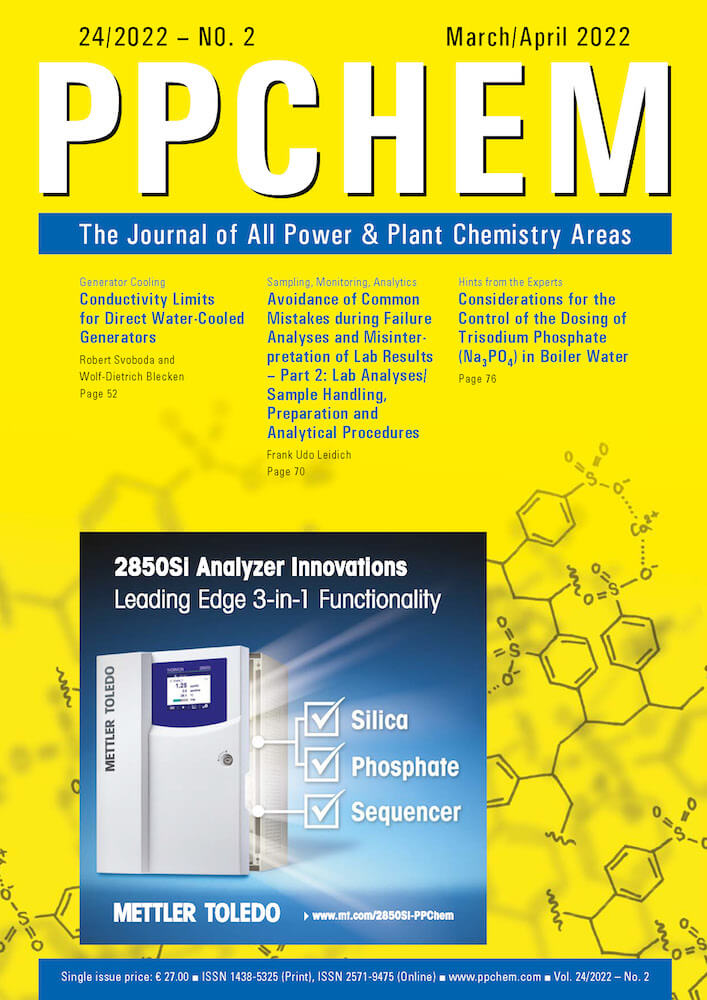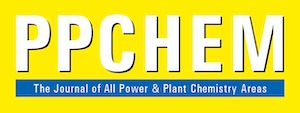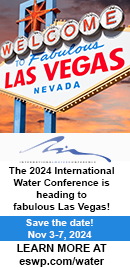
For members only
ABSTRACTS
Conductivity Limits for Direct Water-Cooled Generators
Robert Svoboda and Wolf-Dietrich Blecken
For normal operation, a conductivity limit of ≤ 0.2 μS · cm–1 is an indirect indicator of correct pH and restricts undue corrosion. With protective additives, e.g., NaOH for alkaline treatment, a higher limit corresponding to the objective of the treatment is appropriate.
With too high conductivity the water inside the insulating hoses of high-voltage stator windings will warm up and if it boils there is a risk of electric flashover inside the insulating hose with damaging consequences. Therefore, a short-term action limit in the order of 10 μS · cm–1 has been set by the industry in the past.
With correct water flow, conductivity inside the insulating hoses at these values does not warm up the water significantly and there are no restrictions regarding the duration of such an event.
However, when cooling water flow is lost, the water inside the insulating hoses will warm up exponentially with time. The time until boiling has a strong (square) dependence on the rated generator voltage, as well as on the insulating hose length, and has a linear dependence on water resistivity. The spatial position of insulating hoses (hoses are mounted vertically, horizontally, or bent) is also of importance. In addition, the stationary cooling water inside the stator bars, as well as the entire stator winding, is subjected to critical temperatures, especially at high load conditions. Therefore, appropriate action must be taken prior to reaching the water boiling level. To avoid a costly stator winding breakdown, the cooling water flow must be restored at once. Otherwise, the generator has to be shut down completely as soon as possible.
PPCHEM® 2022, 24(2), 52–63
For Members only
Avoidance of Common Mistakes during Failure Analyses and Misinterpretation of Lab Results – Part 2: Lab Analyses / Sample Handling, Preparation, and Analytical Procedures
Frank Udo Leidich
For a proper failure analysis or root cause analysis (RCA), a great deal of data and evidence-based information is needed. Within this context, various types of samples from different locations need to be taken for chemical and/or metallurgical examination. In addition to proper and correct sampling without alteration of the composition or contamination of the samples, which is described in the first article of this short series [1], it is of utmost importance to use the right analytical methods and execute sample preparation carefully. This includes being aware of the basic principles of the methods applied and of course knowing their limits. This article discusses the analytical part of an RCA and is the second part in a short series of ongoing articles.
PPCHEM® 2022, 24(2), 70–75
For Members only
HINTS FROM THE EXPERTS
Considerations for the Control of the Dosing of Trisodium Phosphate (Na3PO4) in Boiler Water
In the recent past, various organizations have been trying to establish a more or less full automatization of the dosing control for the phosphate boiler water treatment (typically called PT), similar to the well-established and well-functioning automatic dosing control of ammonia. Although this may sound easy, as nowadays very reliable instruments and sampling systems are available, it is relatively difficult to implement, especially for PT, as the entire phosphate chemistry is very complex compared to that of ammonia. Therefore a safe and reliable automatic control of PT involves a lot of traps and risks which must be considered. The most common and challenging issues in this respect are described here. Although this list may not be complete, it could be used to reconsider the idea of fully automated control of phosphate dosing.
PPCHEM® 2022, 24(2), 76–81


